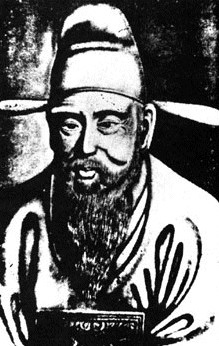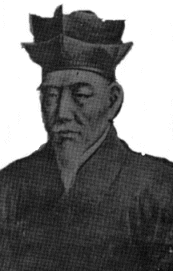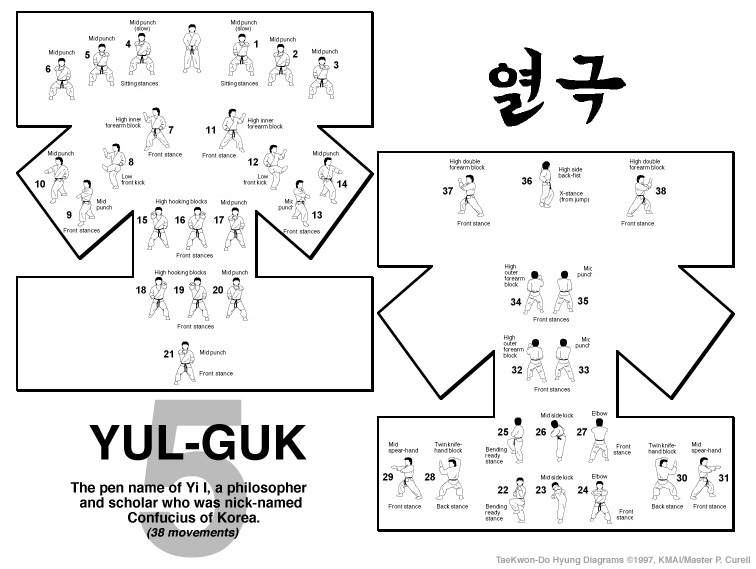Movements - 38
Ready Posture - PARALLEL READY STANCE |
| 1. |
Step out with Left Foot into Square Horse
Stance.
Left Punch. |
| 2. |
Slow Right Punch.
Slow Left Punch. |
| 3. |
Double Right-Left Punch. |
| 4. |
Shuffle step to Right. |
| 5. |
Slow Right Punch.
Slow Left Punch. |
| 6. |
Right Punch. |
| 7. |
Shift to Right Front Stance to 1.5 oclock.
Right Outward Block. |
| 8. |
Left Front Kick. |
| 9. |
Land in Left Forward Stance, Left Punch. |
| 10. |
Right Punch. |
| 11. |
Shift to Left Front Stance to 10.5 oclock.
Left Outward Block. |
| 12. |
Right Front Kick. |
| 13. |
Land in Right Forward Stance, Right Punch. |
| 14. |
Left Punch. |
| 15. |
Shift to Right Forward Stance to 12 oclock. |
| 16. |
Right Press. Left Press. |
| 17. |
Right Punch. |
| 18. |
Step to Left Forward Stance. |
| 19. |
Left Press. Right Press. |
| 20. |
Left Punch. |
| 21. |
Step to Right Forward Stance, Right Punch. |
| 22. |
Step Left to Right Foot, Chamber on Right.
|
| 23. |
Left Side Kick to 12 oclock. |
| 24. |
Land in Left Front Stance, Right Elbow Smash.
|
| 25. |
Step Right to Left Foot and Chamber on the
Left. |
| 26. |
Right Side Kick to 6 oclock. |
| 27. |
Land in Right Front Stance, Left Elbow Smash.
|
| 28. |
Step to Left Back Stance to 3 oclock, C-Block. |
| 29. |
Step to Right Forward Stance, Right Spear Hand. |
| 30. |
Step to Right Back Stance to 9 oclock, C-Block. |
| 31. |
Step to Left Forward Stance, Left Spear Hand. |
| 32. |
Shift to Left Forward Stance to 6 oclock, Left Outward
Block. |
| 33. |
Right Punch. |
| 34. |
Step to Right Forward Stance, Right Outward Block. |
| 35. |
Left Punch. |
| 36. |
Jump into X-Stance Facing 9 oclock, Left Backfist. |
| 37. |
Step to Left Front Stance to 9 oclock, Left Reinforced
Outward Block. |
| 38. |
Shuffle to Right Front Stance to 3oclock, Right Reinforced
Outward Block. |
| END: Bring the left foot back to a ready posture. |
He had a very talented and artistic mother.
Born near the town of Kang-Nung in Kwangwon-Do province, Yi
I was fortunate to have a very talented and artistic mother,
Sin Saim-Dang. She was unusually accomplished for a woman of
those times and was known as an excellent painter. Well-respected
throughout Chulla and Kyongsang provinces during her lifetime,
she has become more renowned throughout the world in the last
300 years. It is most likely that her talent had a profound
effect on her son's upbringing: he is said to have been able
to write characters as soon as he could speak, and to have composed
an essay at the age of seven.
Being close to his mother, Yi I was very distressed when she
died in 1559. According to some sources, it was as a result
of this grief that he took refuge in a Zen Buddhist monastery
in the rugged and beautiful Diamond Mountains. During his one-year
stay there, he meditated, reflected on Buddhist philosophy,
and became well-versed in Buddhist teachings. After leaving
this monastery he returned to society and devoted his life to
studying Confucianism. In later years, as he developed into
a renowned philosopher, he acquired the pseudonym Yul-Gok (Chestnut
Valley).
 Yul-Gok was well-known
for his development of a school of thought concerning the philosophy
of the 12th century Confucian scholar Chu-Hsi. Chu-Hsi established
the concepts of "li" (reason or abstract form) and
"chi" (matter or vital force). He proposed that these
two concepts were responsible for all human characteristics
and the operation of the universe. As he defined the concepts,
they are very similar to the concepts of body and soul in I
Western philosophy and I religion. The "li," however,
is not totally synonymous with the idea I instead represents
groups or models for each form of existence. Yul-Gok's school
of thought supported the concept that the "chi" was
the controlling agent in the universe and that the "li"
was a supporting component. Experience, education, and practical
intellectual activities were stressed in this school of thought.
The other major school of thought stemming., from the philosophy
of Chu Hsi was fostered by Yi Hwang (Yi Toi
Gye), who proposed that the "li" controlled the
"chi" and stressed the importance of moral character
building.
Yul-Gok was well-known
for his development of a school of thought concerning the philosophy
of the 12th century Confucian scholar Chu-Hsi. Chu-Hsi established
the concepts of "li" (reason or abstract form) and
"chi" (matter or vital force). He proposed that these
two concepts were responsible for all human characteristics
and the operation of the universe. As he defined the concepts,
they are very similar to the concepts of body and soul in I
Western philosophy and I religion. The "li," however,
is not totally synonymous with the idea I instead represents
groups or models for each form of existence. Yul-Gok's school
of thought supported the concept that the "chi" was
the controlling agent in the universe and that the "li"
was a supporting component. Experience, education, and practical
intellectual activities were stressed in this school of thought.
The other major school of thought stemming., from the philosophy
of Chu Hsi was fostered by Yi Hwang (Yi Toi
Gye), who proposed that the "li" controlled the
"chi" and stressed the importance of moral character
building.
"He was a man that knew the realism of heaven"
This school of thought was carried over into Yi-I's personal
life. In fact, he took sincerity very seriously: "A sincere
man," he felt, "was a man that knew the realism of
heaven." He once wrote that a house could not sustain harmony
unless every family member was sincere. He felt that when confronted
with misfortune, a man must carry out a deep self-reflect/on
to find and correct his own mistakes In addition to his commitment
to society, Yul-Gok emphasized the value of practical application.
The reason for study, he asserted, was to apply the knowledge
one has gained. As an example of his dedication to this belief
he is said to have manufactured his own hoes and worked at the
bellows, which was not usually done by a person of his stature.
This attitude toward life was consistent with his concern for
the improvement of the individual as well as for society as
a whole
His concern for sincerity, loyalty, and the improvement of
the individual was manifested in his own actions toward others.
Yi's stepmother enjoyed drinking wine, a practice Yul-Gok never
approved of. Every morning, year after year, he brought her
several cups of wine, never reproaching her for her habit. Finally,
she decided on her own to stop drinking without ever having
been told of his displeasure. In gratitude for those years of
non-judgmental dedication, YulGok's stepmother clad herself
in white mourning attire for three years after his death. Yul-Gok
was also deeply involved in government and public affairs. He
passed the state examinations at the very young age of 24 and
was ultimately appointed to several ministerial positions including
that of Minister of Defense. He did more for establishing a
mechanism to obtain the opinion of the common people, a national
consensus, than any man in Korean history. Popular opinion of
the masses, he felt, must arise spontaneously from the total
population. He knew that the survival and vitality of a kingdom
depended directly upon whether public opinion was obtained from
ale sections of the population. Yul-Gok felt that public resentment
could be directly attributed to misrule. Rulers should, therefore,
pay closer heed to the voices of their subjects. He was convinced
that when impoverished people are deprived of their humanity,
morality crumbles and penal systems are rendered ineffective.
Because of his beliefs and his fear for the survival of the
kingdom, Yul-Gok initiated many attempts at government reform.
In one such effort, Yul-Gok sought to establish local government
structures that were based on an education according to the
philosophy of Chu-Hsi. He drew up set of village articles (Hang-Yak)
designed to instruct the villagers of Haeju in Confucian ethics.
This government, however, was run by the elite class (Yang-Ban)
and ultimately failed due to corruption.
Great reformer.
Yul-Gok was also the firs to propose the Tendong (Great
Equity) System for solving the financial crisis of the Korean
government Under the Tendong System taxes would be levied or
land rather than on house holds arid government would be required
to purchase local products wit' tax dollars.
Pulled into political conflict
In addition to his active involvement, Yul-Gok was
also inadvertently pulled into a serious political squabble
by  virtue of his philosophy.
In 1575 the Korean government became mired down in a political
stalemate that ultimately contributed to its inability to repulse
the invasion by Japan so me ten years later. Two distinct factions,
polarized within the Korean government, were constantly at each
other's throats. These factions originally arose as e result
of personal quarrel between two men, Sim Ui-Gyom and Kim Hyo-Won
Ultimately, every official in the government had to align himself
with one side or the other or risk attack by both Since Kim
s residence was in the Eastern quarter of Seoul and Sim was
in tile western quarter, these two factions became known as
the Easterners and the Westerners, respectively. This feuding
continued long after Kim and Sim had disappeared from public
life, and of ten took the guise of schemes designed to have
members of the rival faction exiled, removed from office, or
executed on false charges. These two factions were not only
at odds politically but soon became philosophically opposed,
with the easterners following the teachings of Yi-Hwang and
the western faction following the teachings of Yul-Gok These
philosophical differences tended to drive the two factions further
apart, increased the conflicts, and made the functioning of
government virtually impossible.
virtue of his philosophy.
In 1575 the Korean government became mired down in a political
stalemate that ultimately contributed to its inability to repulse
the invasion by Japan so me ten years later. Two distinct factions,
polarized within the Korean government, were constantly at each
other's throats. These factions originally arose as e result
of personal quarrel between two men, Sim Ui-Gyom and Kim Hyo-Won
Ultimately, every official in the government had to align himself
with one side or the other or risk attack by both Since Kim
s residence was in the Eastern quarter of Seoul and Sim was
in tile western quarter, these two factions became known as
the Easterners and the Westerners, respectively. This feuding
continued long after Kim and Sim had disappeared from public
life, and of ten took the guise of schemes designed to have
members of the rival faction exiled, removed from office, or
executed on false charges. These two factions were not only
at odds politically but soon became philosophically opposed,
with the easterners following the teachings of Yi-Hwang and
the western faction following the teachings of Yul-Gok These
philosophical differences tended to drive the two factions further
apart, increased the conflicts, and made the functioning of
government virtually impossible.
A great philosopher.
In 1583, a year before his death, Yul-Gok proposed that the
government train and equip a 100,000-man Army Reserve Corps.
This suggestion, like others he recommended, was undermined
by minor officials who were caught up with the east-west political
conflict within the government It was very unfortunate that
this suggestion concerning national security was never allowed
to be implemented. Nine years later, the Korean military forces
and government officials failed totally in their resistance
against the invasion by the Japanese army of Hideyoshi, resulting
in the occupation of Korea.
Although never really permitted to see his theories and systems
applied due to the political environment of the time, Yul-Gok
nonetheless was an extraordinary philosopher. Long after his
death in 1584, Yul-Gok has continued to have a profound effect
Upon Korea and the world as a result of his lifelong dedication
to Confucianism and theory of government.
Print
Pattern and History - 8/14/02


 Yul-Gok was well-known
for his development of a school of thought concerning the philosophy
of the 12th century Confucian scholar Chu-Hsi. Chu-Hsi established
the concepts of "li" (reason or abstract form) and
"chi" (matter or vital force). He proposed that these
two concepts were responsible for all human characteristics
and the operation of the universe. As he defined the concepts,
they are very similar to the concepts of body and soul in I
Western philosophy and I religion. The "li," however,
is not totally synonymous with the idea I instead represents
groups or models for each form of existence. Yul-Gok's school
of thought supported the concept that the "chi" was
the controlling agent in the universe and that the "li"
was a supporting component. Experience, education, and practical
intellectual activities were stressed in this school of thought.
The other major school of thought stemming., from the philosophy
of Chu Hsi was fostered by Yi Hwang (Yi
Yul-Gok was well-known
for his development of a school of thought concerning the philosophy
of the 12th century Confucian scholar Chu-Hsi. Chu-Hsi established
the concepts of "li" (reason or abstract form) and
"chi" (matter or vital force). He proposed that these
two concepts were responsible for all human characteristics
and the operation of the universe. As he defined the concepts,
they are very similar to the concepts of body and soul in I
Western philosophy and I religion. The "li," however,
is not totally synonymous with the idea I instead represents
groups or models for each form of existence. Yul-Gok's school
of thought supported the concept that the "chi" was
the controlling agent in the universe and that the "li"
was a supporting component. Experience, education, and practical
intellectual activities were stressed in this school of thought.
The other major school of thought stemming., from the philosophy
of Chu Hsi was fostered by Yi Hwang (Yi  virtue of his philosophy.
In 1575 the Korean government became mired down in a political
stalemate that ultimately contributed to its inability to repulse
the invasion by Japan so me ten years later. Two distinct factions,
polarized within the Korean government, were constantly at each
other's throats. These factions originally arose as e result
of personal quarrel between two men, Sim Ui-Gyom and Kim Hyo-Won
Ultimately, every official in the government had to align himself
with one side or the other or risk attack by both Since Kim
s residence was in the Eastern quarter of Seoul and Sim was
in tile western quarter, these two factions became known as
the Easterners and the Westerners, respectively. This feuding
continued long after Kim and Sim had disappeared from public
life, and of ten took the guise of schemes designed to have
members of the rival faction exiled, removed from office, or
executed on false charges. These two factions were not only
at odds politically but soon became philosophically opposed,
with the easterners following the teachings of Yi-Hwang and
the western faction following the teachings of Yul-Gok These
philosophical differences tended to drive the two factions further
apart, increased the conflicts, and made the functioning of
government virtually impossible.
virtue of his philosophy.
In 1575 the Korean government became mired down in a political
stalemate that ultimately contributed to its inability to repulse
the invasion by Japan so me ten years later. Two distinct factions,
polarized within the Korean government, were constantly at each
other's throats. These factions originally arose as e result
of personal quarrel between two men, Sim Ui-Gyom and Kim Hyo-Won
Ultimately, every official in the government had to align himself
with one side or the other or risk attack by both Since Kim
s residence was in the Eastern quarter of Seoul and Sim was
in tile western quarter, these two factions became known as
the Easterners and the Westerners, respectively. This feuding
continued long after Kim and Sim had disappeared from public
life, and of ten took the guise of schemes designed to have
members of the rival faction exiled, removed from office, or
executed on false charges. These two factions were not only
at odds politically but soon became philosophically opposed,
with the easterners following the teachings of Yi-Hwang and
the western faction following the teachings of Yul-Gok These
philosophical differences tended to drive the two factions further
apart, increased the conflicts, and made the functioning of
government virtually impossible.